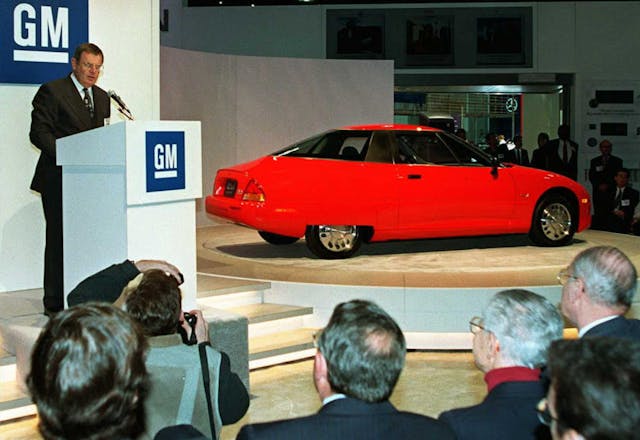Media | Articles
Horsepower’s Relentless March: 1980-2000
This story first appeared in the September/October 2024 issue of Hagerty Drivers Club magazine. Join the club to receive our award-winning magazine and enjoy insider access to automotive events, discounts, roadside assistance, and more.
The following multi-part series explores the developmental timeline of horsepower in the automotive industry. We kicked things off with the engine’s early development, from 1776-1900, here. Time marched on, and so did our coverage—through the early 20th century, the eventful decades of the ’20s-40s, as things heated up in the ’50s and adjusted to a changing world from the ’60-80s. Stay tuned as we continue our daily installments highlighting all the major evolutionary milestones in horsepower. Enjoy! –Ed.
How much horsepower does it make? The question is, in many practical respects, pointless. Pretty much every vehicle on the road has enough power to do what it needs to do, and then some. Yet for enthusiasts, it’s critical, part of a secret handshake that tells us not only what someone’s driving, but whether they know and appreciate what they’re driving.
The horsepower your car produces is the product of some 250 years of continuous improvement, serendipitous discoveries, and daring feats—most of it revolving around a type of air pump we call the internal combustion engine.
As we write this, the future of the engine, the beating heart of the automobile, is somewhat in doubt. There’s no question, though, that our horsepower quest will continue. We will keep tweaking, and the numbers will keep growing. But it’s worth pausing, if only for a moment, to reflect on just how far we’ve come.
Marketplace
Buy and sell classics with confidence
***

1981: The Maserati Biturbo launches and is, as the name hints, the first production car with twin turbochargers. Of course, this was a learning experience—making more than one turbocharger work required careful development. Turbocharger design has since evolved over the years, with improved bearings as well as more efficient rotor and housing configurations.

1986: At Bonneville, Sherman spins at just over 200 mph in a Mazda RX-7 powered by a 530-hp, twin-turbo rotary engine. After confirming neither he nor the car were worse for wear, he goes for broke on the next two runs, with an average speed of 238.442 mph.

1992: At the initiative of Chrysler president Bob Lutz, Dodge creates a modern Cobra, called the Viper. It is the first car powered by a V-10—the company’s small-block V-8 with two more cylinders tacked to it. This results in uneven firing intervals, due to the 90-degree block and crank-throw starting points. (The preferred V-angle for V-10s is 72 degrees, but employing that arrangement would have required expensive new tooling.) But it makes 400 horsepower.

1993: Hoping to stem the tide of European and Japanese imports, GM launches the Northstar, a four-cam, 32-valve V-8 fitted with an aluminum block and heads. Built in naturally aspirated and supercharged form, displacements ranged from 4.0 to 4.6 liters and output peaked at 469 horsepower. Defying its usual lack of patience, GM kept Northstar aloft for 19 model years.

1996: Following R&D expenditures topping $1 billion, GM revived long-dormant electric automobiles with its EV1, powered by a 137-hp three-phase AC motor. A total of 1117 cars were offered only for lease over a four-year production run. Fearing astronomical service costs, GM recalled nearly every EV1 built, dispatching them to crushers.

1997: Cadillac introduced StabiliTrak electronic stability control.

Royal Air Force pilot Andy Green broke the sound barrier, swooshing at 763 mph across Nevada’s Black Rock Desert in the ThrustSSC. It’s powered by two Rolls-Royce Spey turbo-fan engines. His achievement came 50 years and one day after Air Force pilot Chuck Yeager flew the Bell X-1 rocket-powered Glamorous Glennis to 807 mph in level flight at 45,000 feet over the Muroc Air Force Base in California (now Edwards Air Force Base).

1998: A slightly modified McLaren F1 sports car powered by a 618-hp, 6.1-liter BMW V-12 engine sets a Guinness World Record as the world’s fastest production car by topping 240 mph. The 106 F1s built between 1992 and 2000 had prices starting at $800,000, soon topping a million.
Return to Part V (1960–1980), and stay tuned for Part VII (2000–Present).












No mention of the greatest General Motors powertrain of the 90’s, the LS1?
I would venture to say it has lead to the development of the LS6, LS2, LS7, LS9 and LSA.
The relentless pursuit of power includes the 1997 LS1.
In the 80’s the Japanese imports with their turbos, dohc setups made things very interesting. There were some american versions of this type and the Mustang with the 302 was always interesting as well as LT powered GM cars. In the 90’s Japanese/Europeans continued and the American cars fully joined the party and became very interesting again. The 80’s to 2000’s is probably my favorite period.